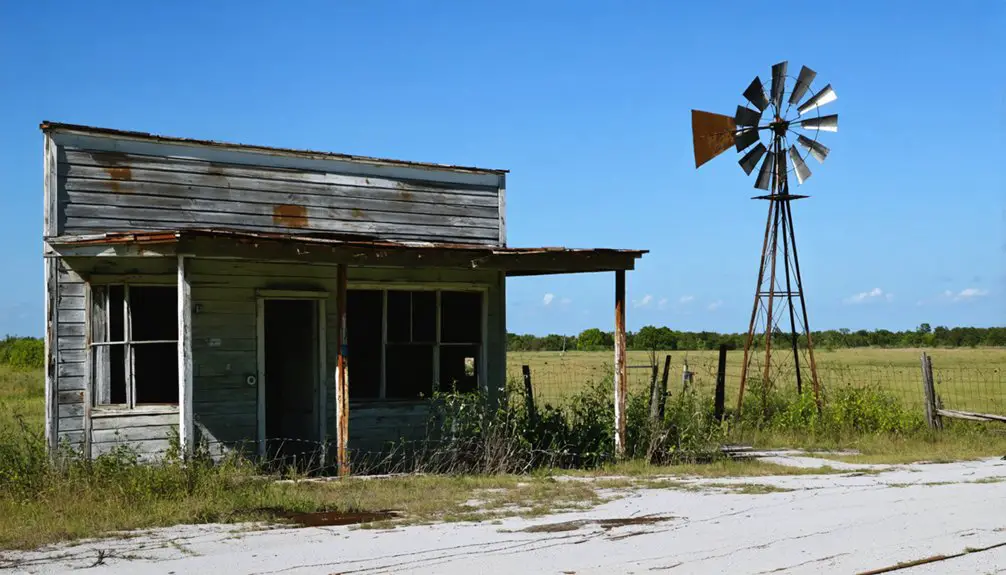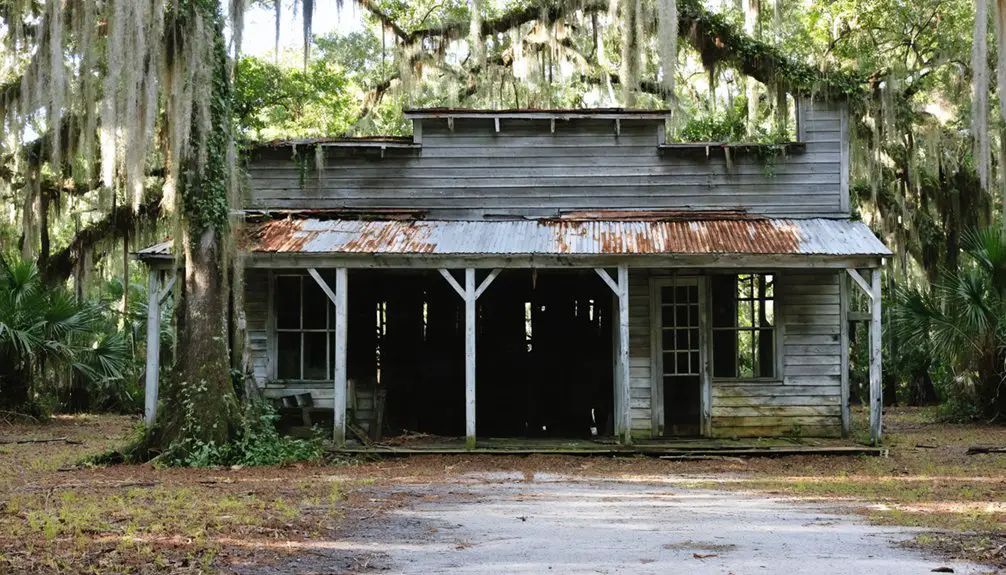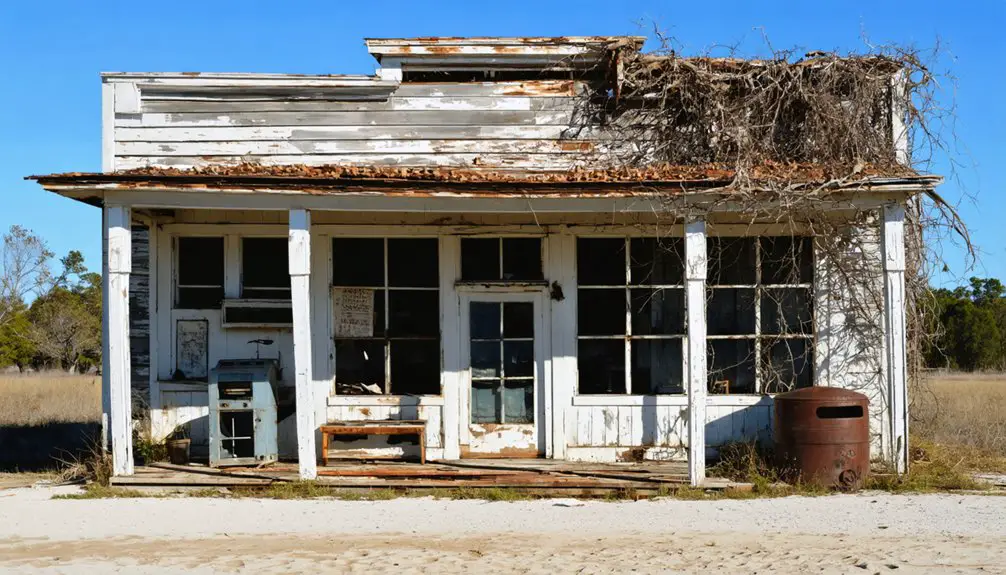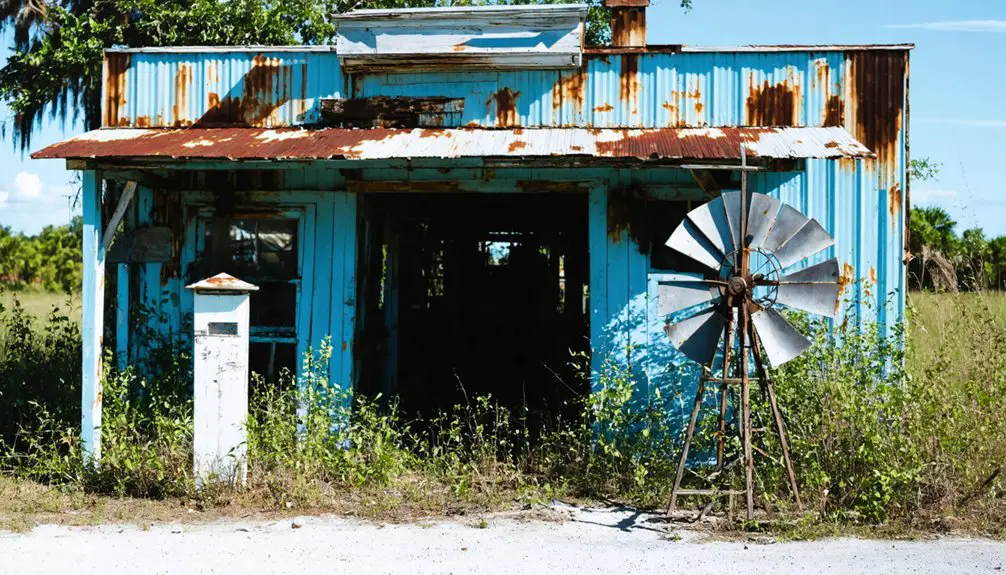You’ll find Kenansville, Florida as a quiet ghost town today, though it emerged in 1910 through Henry Flagler’s railroad expansion. The town flourished as an essential cattle and agricultural hub after relocating from Whittier in exchange for $10,000 and a new school. Regular rail service arrived by 1914, but the end of railroad operations in 1947, coupled with the Florida Land Boom collapse and Great Depression, transformed this once-bustling community into a historic reminder of Florida’s pioneer past.
Key Takeaways
- Kenansville transformed from a thriving railroad town into a ghost town after rail service ended in 1947 and economic activity declined.
- Originally established in 1910 through Henry Flagler’s railroad deal, the town flourished as a cattle and agricultural transportation hub.
- The Florida Land Boom collapse in 1926 and Great Depression initiated the town’s decline, culminating in railroad abandonment.
- Population dwindled to 381 residents with density of one person per square mile, as younger generations left for better opportunities.
- Historic structures like Webb’s Heartbreak Hotel and the 1917 Kenansville School remain as remnants of the town’s prosperous past.
The Birth of a Railroad Town
While many Florida towns sprang up organically around existing settlements, Kenansville’s birth came through a calculated business arrangement with railroad tycoon Henry Flagler in 1910.
You’ll find the town’s origins in a bold town relocation deal, where Flagler surveyed a route for his Florida East Coast Railroad’s Okeechobee Spur and approached the farming community of Whittier with an enticing proposition.
During the railway negotiations, Flagler offered a $10,000 donation for a new school if the town would move adjacent to his rail line and adopt his wife’s maiden name, Kenan.
The residents accepted, and by 1914, regular railroad service transformed the renamed Kenansville into a crucial cattle town. The town quickly established itself with the opening of the Bank of Kenansville that same year. A second rail line followed in 1916, cementing the community’s position as a regional transportation hub. Though Flagler died in 1913, Mary Flagler fulfilled the promise to fund the new school in 1914.
From Whittier to Kenansville: A Name’s Legacy
You’ll find the transformation of Whittier into Kenansville was a direct result of Henry Flagler’s railroad influence, as he offered the town $10,000 for a new school in exchange for relocating and adopting his wife’s maiden name.
The 1910 deal proved beneficial, with Mary Lily Kenan Flagler following through on her late husband’s promise by donating both land and $6,000 for the brick schoolhouse in 1914.
The Kenansville School, completed in 1917, became one of Florida’s finest rural educational facilities and stands today as a symbol of the Flagler legacy that reshaped this small farming community. The school operated continuously until its closure in 1961, remaining shuttered for three decades before reopening. The First State Bank building nearby featured intricate tile work and became a symbol of the town’s brief prosperity during the early 1900s.
Flagler’s Railroad Influence
In 1910, railroad magnate Henry Flagler forever changed the destiny of a small farming community called Whittier when he proposed a pivotal deal: rename and relocate the town in exchange for railroad access and a $10,000 school donation.
This strategic move was part of Flagler’s legacy of expanding the Florida East Coast Railway southward. The town was named after Flagler’s wife Mary Lily Kenan. By 1914, you’d find regular rail service at Kenansville’s depot, connecting the town to Flagler’s vast network via the Okeechobee Spur. Like his successful developments in Palm Beach and Miami, Flagler’s railroad expansion brought unprecedented opportunities for growth and tourism.
The railroad’s arrival transformed Kenansville into a thriving cattle town, while facilitating the transport of turpentine and agricultural products to broader markets. A second rail line opened in 1916, though it was later abandoned after the 1926 Florida Land Boom bust.
Flagler’s railroad expansion brought unprecedented growth to the region until service ended in 1947.
Mary Kenan’s Lasting Impact
Behind Kenansville’s transformation from Whittier lay the remarkable influence of Mary Lily Kenan, whose marriage to Henry Flagler in 1901 would shape the town’s destiny.
Their wedding at Liberty Hall was an intimate gathering of just 27 guests in a small-town parlor, setting a humble tone for their future impact on the region.
Born and raised in Wilmington, North Carolina, Mary brought her southern roots and cultural sensibilities to Florida’s development.
When Flagler established his railroad route in 1910, you’ll discover how Mary Kenan’s name became forever linked to this rural community’s identity.
- Mary’s commitment to education transformed the town through her $6,000 donation and five acres for a brick schoolhouse in 1914.
- Her fulfillment of Flagler’s promised $10,000 school fund after his death in 1913 showed her dedication to community development.
- Under her management, the Florida East Coast Railroad and associated companies continued to thrive.
- Her impact extended beyond her death in 1917, with her $100 million estate supporting various trusts and cultural projects that shaped Florida’s development.
The Mary Lily Kenan School Legacy
In 1914, you’d have witnessed Mary Lily Kenan honor her late husband Henry Flagler‘s promise by donating five acres and $6,000 to establish what would become one of Florida’s most outstanding rural schools.
The brick schoolhouse, designed by A.J. MacDonough and opened in 1917, served K-12 students with five teachers across four rooms, establishing a reputation for educational excellence that lasted until its closure in 1961.
Today, you can explore the restored school building, which stands as a museum under the care of the Kenansville Community Association, preserving both the architectural heritage and educational legacy of early 20th-century rural Florida. During its peak years, the school accommodated as many as 100 students before enrollment began declining in the 1920s.
School’s Early Educational Excellence
Excellence marked the Mary Lily Kenan School from its 1917 opening, establishing itself as one of Florida’s finest rural educational institutions.
You’ll find the school set exceptional educational standards for rural schooling, with its innovative multi-grade teaching approach and emphasis on fundamental academic skills.
- Five dedicated teachers managed multiple grades per classroom, serving over 100 students from kindergarten through high school.
- County officials in the 1950s praised the school’s students for their superior academic preparation compared to peers.
- The curriculum’s strength attracted recognition as one of Florida’s most outstanding rural schools.
- The two-story brick schoolhouse represented modern educational facilities of its era, featuring four well-equipped classrooms for thorough instruction.
The dedicated Miss Anne Hampton taught at the school for three decades, contributing to its educational legacy.
The school’s academic excellence created a lasting impact on rural education in early 20th century Florida.
Mary Kenan’s Philanthropic Vision
Mary Lily Kenan’s transformative philanthropy shaped Kenansville’s educational landscape when she donated five acres of land and $6,000 in 1914 to fulfill her late husband Henry Flagler’s promise. Her philanthropic initiatives led to the construction of a two-story brick school building, completed in 1916, that would serve as a beacon of educational empowerment for decades.
You’ll find her legacy extends far beyond the school’s walls. With an estate valued at $100 million upon her death in 1917, she established the Kenan Professorship Fund and created trusts to protect Florida’s essential infrastructure, including railroad interests.
The town itself was renamed Kenansville in her honor, recognizing how her vision linked educational development with regional growth. Today, the school building stands as the oldest masonry school in the area, a symbol of her enduring impact.
Building Preservation Efforts Today
Three distinct phases mark the preservation journey of the Kenansville School building since its initial closure in 1961.
The first saw community involvement successfully petition for its reopening in 1992, serving pre-K to third grade until 2003.
The second phase began in 2005 when the Kenansville Community Association took ownership to oversee preservation of the historic two-story brick structure.
- Ongoing restoration aims to restore architectural integrity of the 1916 masonry vernacular design
- A rejected 2008 National Register application spurred efforts to return the building to its original condition
- The school now serves as a museum showcasing local heritage
- Local volunteers and historians maintain the site, including a relocated historic post office displayed nearby
Golden Age of Cattle and Agriculture

While Kenansville began as the farming community of Whittier in the late 1800s, it truly blossomed after 1910 when Henry Flagler’s promise of railroad access transformed the settlement into a thriving cattle and agricultural hub.
You’ll find that cattle ranching dominated the local economy through the 1940s, with experts like Lawrence Silas leading the way in cattle health and management. He expanded his father’s 160-acre estate, demonstrating the prosperity possible through skilled ranching practices.
The region’s agricultural heritage centered on the distinctive Florida Cracker cattle, a heat-tolerant breed perfectly adapted to the local climate.
Ranchers managed their herds on open ranges until 1949, when fencing laws changed the traditional cattle-driving landscape forever. The railroad’s end in 1947 marked the close of Kenansville’s golden age.
Railroad’s Rise and Fall
You’ll find Kenansville’s transformation into a thriving cattle town began with Henry Flagler’s 1910 decision to extend the Florida East Coast Railway nearby, prompting the town’s relocation and renaming in honor of his wife Mary Lily Kenan.
By 1915, the railroad depot had established regular service, and a secondary line, the South Florida and Gulf Railroad, branched off toward Prairie Ridge in 1916, making Kenansville an essential transportation hub for cattle and turpentine operations.
The town’s prosperity proved short-lived, as the collapse of the Florida Land Boom in 1926 and the Great Depression led to the abandonment of rail service by 1947, marking the beginning of Kenansville’s decline into a ghost town.
Early Railroad Development
Before Henry Flagler’s ambitious Florida East Coast Railway transformed Kenansville’s landscape in 1915, Florida’s railroad development had already established significant roots through earlier initiatives.
You’ll find that railroad construction began in 1836 with the steam-powered Lake Wimico and St. Joseph line serving Port St. Joe.
By 1855, the pioneering Florida Railroad undertook a bold expansion through challenging terrain:
- Construction crews, primarily slave laborers, carved through dense forests and treacherous swamps.
- A single locomotive transported all equipment, taking a full year to complete just 10 miles.
- By 1860, the line stretched 155.5 miles, becoming Florida’s best-equipped railroad.
- The completion to Cedar Key in 1861 created essential trade routes that bypassed the Florida Keys, connecting isolated rural communities.
Railroad’s Economic Impact
The arrival of Henry Flagler’s Florida East Coast Railroad in 1915 marked the beginning of Kenansville’s most prosperous era.
You’ll find that rail freight services transformed this small town into a thriving cattle and turpentine hub, connecting local producers to larger markets while greatly reducing transportation costs. The economic revival brought new jobs, sparked the construction of a brick schoolhouse in 1917, and attracted supporting businesses to the area.
However, when rail service ended in 1947, Kenansville’s fortunes reversed dramatically.
You can trace the town’s decline through rising freight costs, business relocations, and eventual closure of key institutions like the school in 1961. Without the railroad’s economic multiplier effect – where each rail job supported nearly four other positions – Kenansville couldn’t maintain its previous liveliness and gradually transformed into the quiet community you see today.
Post-Railroad Town Decline
Once rail service ended in 1947, Kenansville’s economic importance unraveled rapidly.
The town’s transportation evolution from a bustling cattle shipping hub to an isolated community reflected broader changes sweeping across rural America. Railroad nostalgia remains strong among locals who remember when trains brought energy and connection to their community.
You’ll find these defining changes shaped Kenansville’s decline:
- The Florida Turnpike’s construction diverted traffic from US-441, severing essential commercial flows
- Local institutions vanished, including the town’s school closure in 1961
- The banking sector never recovered after the Great Depression
- Cattle and agricultural industries struggled with higher transportation costs
Without its railroad lifeline, Kenansville transformed from a dynamic market center into a quiet farming community, its population dwindling as residents sought opportunities in better-connected towns.
Webb’s Heartbreak Hotel Mystery
Standing as one of Kenansville’s few preserved historic buildings, Webb’s Heartbreak Hotel harbors an intriguing connection to Elvis Presley’s iconic 1956 hit song. The mystery origins of this relationship have fueled local speculation for decades, though Elvis never actually stayed at the establishment.
Originally opened in 1915 as the Piney Woods Inn, the building fell into disrepair until Reverend James W. Webb purchased and renovated it in 1955.
The folklore connections intensified after Webb painted the building red and renamed it “Heartbreak Hotel” – a name local kids had already given it due to its rundown state.
While the true inspiration for Elvis’s song remains debated, the hotel’s story intertwines with Kenansville’s transformation from a bustling railroad town to a quiet reminder of Florida’s rural past.
Along the Historic Peavine Trail

Running through the heart of old Kenansville, Peavine Trail traces what was once an essential railroad route connecting the town to Prairie Ridge and beyond.
As you explore this historic pathway, you’ll discover its transformation from the South Florida and Gulf Railroad track to a crucial cattle trade corridor, and finally to today’s recreational trail.
- You’re walking on the exact route where weekly trains once carried passengers and freight before the line’s abandonment in 1918.
- The trail served as a “cowboy highway” before Highway 441, linking cattle operations to major shipping points.
- You’ll find yourself surrounded by Florida’s largest dry prairie ecosystem, featuring seasonal wildflowers and diverse wildlife.
- This path tells the story of Kenansville’s rise and fall, from a bustling 550 residents to just 60 after the railroad’s closure.
Economic Challenges and Population Decline
Beyond the abandoned rails of Peavine Trail lies a sobering story of economic hardship.
You’ll find that Kenansville’s decline began during the Great Depression when it lost its bank, but the real blow came in the 1950s with the railroad’s closure. This double hit created economic isolation that the town couldn’t overcome.
You can trace the community’s struggle through its dependence on cattle trading, which withered as transportation routes shifted away.
When the Florida Turnpike diverted traffic from US 441, it sealed Kenansville’s fate. Despite the community’s resilience, the lack of economic diversification proved devastating.
The population dwindled to a few hundred, mostly descendants of pioneer families, as younger generations left seeking opportunities elsewhere. Without new industries or tourism to sustain it, Kenansville’s economy continued its downward spiral.
Preservation of Pioneer Heritage

While many Florida ghost towns fade into obscurity, Kenansville’s residents have worked tirelessly to preserve their pioneer heritage through strategic building restoration and community engagement.
The Kenansville School, built in 1916 with Mary Lily Kenan’s support, stands as the cornerstone of these preservation efforts.
You’ll find these key preservation initiatives in action:
- Ongoing restoration of the 1916 schoolhouse, which operated until 2003 and once served as an art gallery.
- Collection and display of educational artifacts showcasing pioneer-era teaching methods.
- Relocation of historic structures like the old post office to prevent their loss.
- Partnership with the Pioneer Florida Museum to maintain craft demonstrations and pioneer lifestyle exhibits.
The community’s grassroots activism continues to protect these irreplaceable pieces of Florida’s rural heritage.
Modern Day Rural Life and Historic Sites
Today’s Kenansville stands as a tribute to rural Florida life, with its sparse population of 381 residents spread across vast open spaces at just over one person per square mile.
You’ll find a community where the rural lifestyle reflects both challenges and enduring charm, with limited public services and an aging population whose median age tops 52 years.
The town’s historic sites echo its railroad heritage and cattle-industry roots, including the legendary Heartbreak Hotel that’s linked to Elvis Presley’s musical inspiration.
While community engagement faces hurdles with few local businesses and no public schools, you’ll discover a place where property values remain accessible.
Despite economic struggles, with nearly 29% of residents living below the poverty line, Kenansville preserves its pioneer spirit through its historic landmarks and unhurried way of life.
Frequently Asked Questions
What Was the Population of Kenansville at Its Peak?
While Kenansville’s history and population trends aren’t precisely documented, you’d find that at its peak in the early 1900s, the town likely had several hundred residents during the railroad-driven cattle boom.
Are There Any Remaining Businesses Operating in Kenansville Today?
While traditional Main Street shops have vanished, you’ll find current businesses focused on nature tourism, including Wild Florida Airboats, Double C Bar Ranch Blueberries, and Partin Ranch’s seasonal attractions.
What Happened to Mary Lily Kenan After Donating to the School?
After donating to the school, Mary Lily Kenan married Robert Worth Bingham in 1916, but died suddenly in July 1917, leaving a $100 million estate that established her legacy through education trusts.
Can Visitors Explore the Abandoned Buildings and Historic Sites Freely?
You can’t freely explore abandoned buildings as they’re privately owned and off-limits. There aren’t organized ghost tours – you’ll need owner permission for interior access to historic structures.
Did Elvis Presley Ever Actually Visit Webb’s Heartbreak Hotel?
Ever wonder about those Elvis sightings at Webb’s Heartbreak Hotel? You won’t find any proof he visited – historical records show he never stayed there, despite popular myths about the hotel’s history.
References
- https://beyond.nvexpeditions.com/florida/kenansville.php
- https://floridahistoryblog.com/kenansville-is-a-tiny-town-with-a-rich-history/
- https://www.ghosttowns.com/states/fl/kenansville.html
- https://abandonedfl.com/kenansville-school/
- https://www.youtube.com/watch?v=VEHiJtYkuD0
- https://www.florida-backroads-travel.com/kenansville-florida.html
- http://www.gribblenation.org/2018/02/ghost-town-tuesday-yeehaw-junction-and.html
- https://www.youtube.com/watch?v=9zSFAshAumo
- http://www.geocities.ws/krdvry/hikeplans/kenansville/plankenansvil.html
- https://en.wikipedia.org/wiki/Florida_East_Coast_Railway



